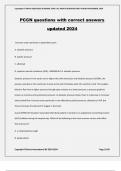Exam (elaborations)
PCCN questions with correct answers updated 2024
Institution
Practice Tests
PCCN questions with correct answers
updated 2024
Coronary artery perfusion is dependent upon:
A. diastolic pressure
B. systolic pressure
C. afterload
D. systemic vascular resistance (SVR) - ANSWER-A. diastolic pressure
Diastolic pressure in the aortic root is higher than left ventricular end...
[Show more]
Preview 4 out of 105 pages
Uploaded on
November 4, 2024
Number of pages
105
Written in
2024/2025
Type
Exam (elaborations)
Contains
Questions & answers
Institution
Practice Tests
Course
Practice Tests
$13.49
100% satisfaction guarantee
Immediately available after payment
Both online and in PDF
No strings attached
Copyright © KAYLIN 2024/2025 ACADEMIC YEAR. ALL RIGHTS RESERVED FIRST PUBLISH NOVEMBER, 2024




